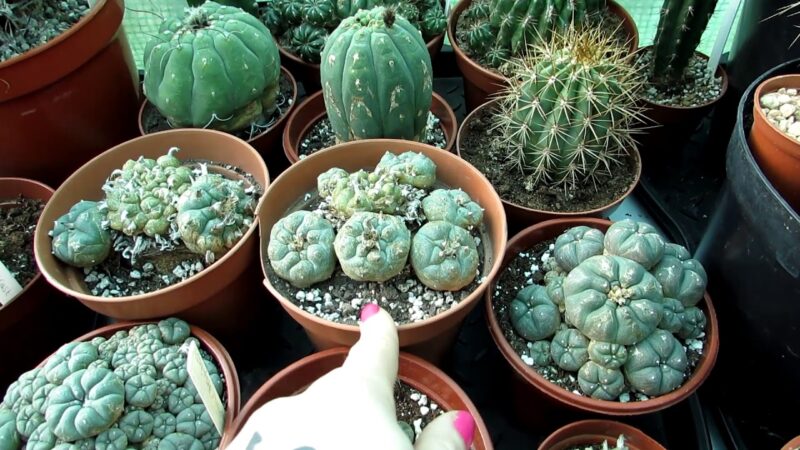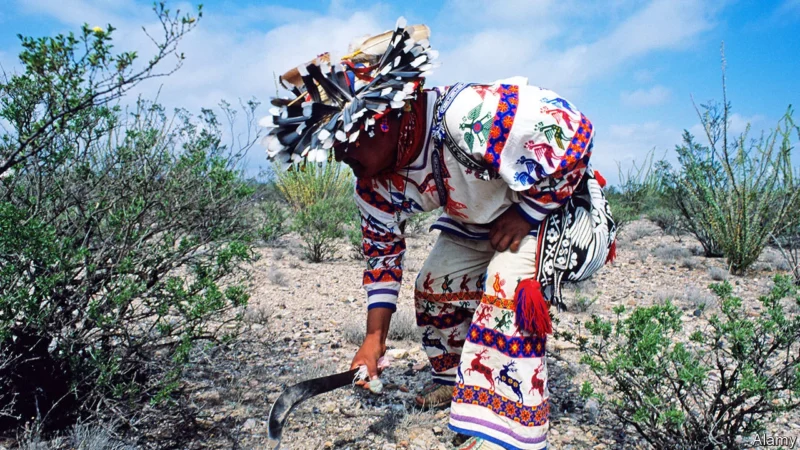
All You Need to Know About San Pedro Cactus and Peyote
Hallucinogenic cacti have made a name for themselves in the psychedelic and mental wellness retreat space as being a great aid for spiritual exploration, connecting with nature, reducing symptoms of anxiety and depression, and more.
Here, you’ll learn all you need to know about San Pedro cactus and Peyote, including what they are, why they’re hallucinogenic, their effects, and how to grow them.
Table of Contents
Why Are Some Cacti Psychedelic?
Some cacti are psychedelic because they have evolved to produce mescaline as a defense mechanism against herbivores.
Mescaline is a psychoactive alkaloid found in various cacti species, including Peyote, San Pedro, and Peruvian Torch cactus.
When consumed, mescaline interacts with serotonin receptors in the brain, leading to hallucinations, changes in thought patterns, and other altered states of consciousness.
What Is San Pedro Cactus (Mescaline)?
San Pedro cactus is a tall columnar cactus native to the Andes Mountains in South America.
It contains mescaline and has been used in traditional shamanic practices for its therapeutic and spiritual effects.
What Is Peyote (Mescaline)?
Peyote is a small, spineless, and button-like cactus that’s native to the Chihuahuan Desert and strongly linked to Indigenous and religious practices.
Peyote typically contains a higher percentage of mescaline than San Pedro.
It has been used traditionally in Native American religious practices for its hallucinogenic effects.
Peyote & San Pedro Cactus Psychedelic Effects
Some of the most common Peyote and San Pedro cactus psychedelic effects include:
- Enhanced or altered perception
- Visual and auditory hallucinations
- Euphoria
- Emotional changes
- Spiritual insights
- Introspection
- Changes in thought patterns
- Feeling connected to nature
Know that you may not experience all these effects. Also, your individual physiognomy and mental state, setting, dosage, and other factors will influence your experience.
Usually, it takes 30 minutes to 2 hours for the effects to begin and may last up to 12 hours, peaking around 2 to 3 hours after ingestion.
In addition, consuming psychedelic cacti comes with potential negative effects such as:
- Anxiety and paranoia
- Nausea and vomiting
- Increased body temperature, heart rate, and blood pressure
- Excessive sweating
- Dehydration
- Headaches
- Muscle weakness
- Impaired motor coordination
Peyote and San Pedro Cactus’ Hallucinogenic Properties
Here’s what you can expect from Peyote and San Pedro cactus hallucinogenic properties:
- Colors become more vivid and vibrant
- Sounds become distorted or heightened
- Stationary objects may seem to shift in form or size
- Some people experience “synesthesia” (e.g., they hear colors or see sounds)

How Do You Consume Cactus Medicines?
There are a few ways you can consume cactus medicines, including:
- Chewing fresh or dried Peyote buttons or San Pedro cactus sections
- Boiling dried cactus to make a brew or tea (the most efficient and traditional method)
- Soaking fresh or dried cactus to create an intoxicating liquid
- Grinding dried cactus into a powder and swallowing it
- Putting that powder into gelatin capsules
- Smoking that powder (not recommended)
How Do You Smoke Peyote?
To smoke Peyote, you need to dry the buttons, grind them into a powder, and mix it with a smokable leaf material (e.g., tobacco or cannabis).
However, this method is not recommended because it’s inefficient — the effects don’t last as long and aren’t as strong because mescaline is absorbed and processed better by the digestive system rather than through the lungs.
Also, smoking plant material can have adverse health effects like lung irritation.
How Does San Pedro Cactus Grow?
San Pedro cactus grows as a tall, columnar cactus with multiple ridges. It thrives in well-draining soil and needs sunlight and warm temperatures. When mature, it produces white flowers.

San Pedro Cactus Growing Zone: Where Does San Pedro Cactus Grow?
San Pedro cactus is native to the Andes Mountains in South America, namely, to countries like Peru, Ecuador, and Bolivia.
But it can also be grown in other parts of the world, including North America and Europe, as long as it’s under the right conditions — which we’ll go over next.
How to Grow San Pedro Cactus
To grow a San Pedro cactus, you can buy one or propagate it from a plan cutting.
Here are the conditions needed for San Pedro cacti to thrive:
- Warm, dry climates, like Mediterranean, desert, or subtropical regions, are preferred.
- Use well-draining soil like cactus or succulent mix.
- Provide plenty of sunlight; if you live in a colder climate, consider a sunny window-side spot or greenhouse.
- Shield it from frost.
- Water sparingly and allow the soil to dry between watering.
Also, when choosing your planting spot, remember that they grow very large. And, of course, check your local laws and regulations before growing San Pedro cactus.
As we mentioned above, growing San Pedro cactus is possible beyond its native area. Here’s what you need to keep in mind when growing it in the US, Canada, Europe, Australia, or New Zealand:
Growing San Pedro Cactus in the US
San Pedro cactus can thrive in the USA, particularly in regions with arid or desert-like conditions. Coastal areas in southern states are suitable as well.
Growing San Pedro Cactus in Canada
San Pedro cactus can be grown in Canada, especially in warmer and drier regions such as interior British Columbia and southern Alberta. Consider indoor cultivation elsewhere.
Growing San Pedro Cactus in Europe
San Pedro cactus can be cultivated in parts of Europe with mild and Mediterranean climates, including southern Portugal, France, and Italy, parts of Spain, and Greece.
In regions with cooler climates, indoor cultivation with controlled temperature and light conditions is the way to go.
Growing San Pedro Cactus in Australia
San Pedro cactus can grow in parts of Australia with warm and arid climates. Coastal areas in southern and western Australia and parts of Queensland are suitable.
Growing San Pedro Cactus in New Zealand
San Pedro cactus can be grown in warmer microclimates of New Zealand, like Northland, Auckland, and mild coastal areas. Remember to protect it from frost and cold temperatures during winter.
How Does Peyote Grow?
Peyote grows as a small, spherical cactus with a distinctive crown. It prefers well-draining soil, lots of sunlight, and arid conditions to grow.
Where Does Peyote Grow?
Peyote is native to the Chihuahuan Desert in North America, primarily found in parts of Mexico and the southwestern United States.
But it can be grown in indoor environments with controlled conditions or in any other place with a suitable climate.
How to Grow Peyote
To grow Peyote, you need to:
- Choose arid, desert-like conditions, a warm coastal location, or a Mediterranean climate.
- Use well-draining soil — a mix of sand and perlite, for example.
- Provide lots of sunlight but avoid intense, direct sun — Peyote grows best in partial shade.
- Maintain warm temperatures; avoid frost and cold.
- Water sparingly; let the soil dry before watering again.
- Be patient — it grows very slowly.
To control the growing conditions better, plant it in a pot or container that you can move around.
You can grow it from seed or cuttings. However, due to having a higher mescaline concentration, Peyote is likely illegal and hard to find for sale in your country — check your local laws and regulations.
Growing Peyote in the US, Canada, Europe, Australia, or New Zealand
Here’s what you need to keep in mind when growing Peyote outside its native area:
- In the US, stick to arid and desert regions, like parts of Texas.
- In Canada, indoor environments with controlled conditions are your best bet.
- In Europe, Mediterranean climates and coastal areas with mild temperatures are suitable.
- In Australia, arid regions with desert-like conditions work well.
- In New Zealand, some areas with warm microclimates and well-draining soil could be effective.
Key Takeaways on All You Need to Know About San Pedro Cactus and Peyote
San Pedro cactus and Peyote are mescaline-containing, hallucinogenic cacti that can be used for several therapeutic purposes, including:
- Reducing symptoms of anxiety and depression
- Improving mental health
- Connecting with nature
- Aiding spiritual exploration
Depending on where you live, you can grow San Pedro cactus and Peyote outdoors or indoors and make your own brews and teas — don’t forget the check your local laws and regulations.
However, if you want to use psychedelic cacti for therapeutic purposes rather than recreational, you should do it under the guidance of trained professionals.
Learn all you need to know about San Pedro cactus and Peyote retreats in our psychedelic retreat database.

Comments